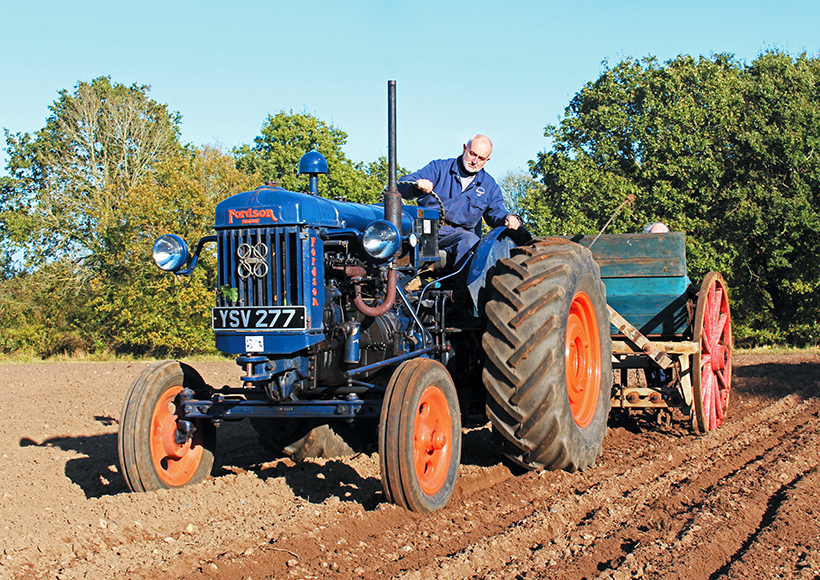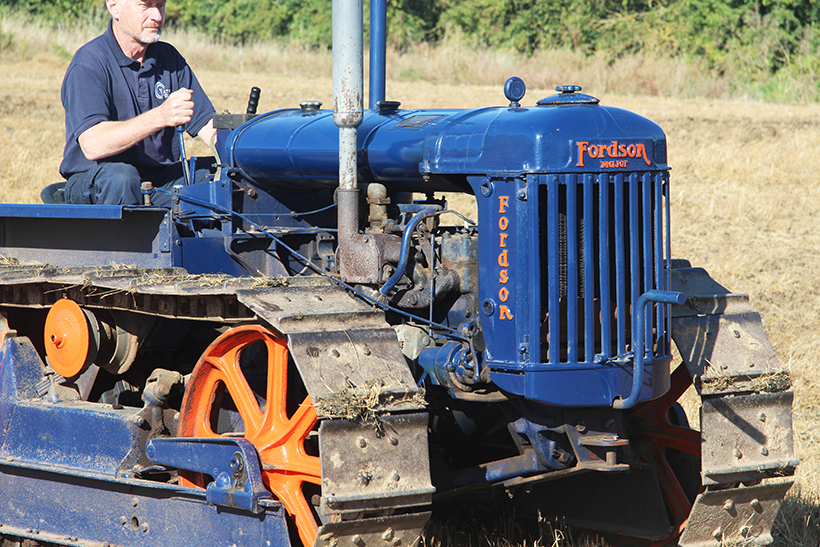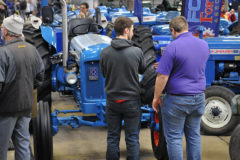A Major celebration
Posted by Chris Graham on 8th April 2020
With the Fordson Major E27N now enjoying its 75th anniversary, Jonathan Whitlam embarks on a Major celebration by looking look at the development of diesel power, the upgrades and the conversions related to this legendary tractor.

A Major celebration: Heavily modified, including much larger than normal rear wheels, this Fordson Major with P6 engine is drilling wheat in Norfolk.
With various tractor builders in Britain once again starting to produce tractors, such as David Brown and the new Ferguson, the Fordson Major was showing just how dated it was with its side-valve engine and very basic construction.
In 1948, Morris launched its first tractor; the Nuffield Universal. This was a larger tractor than that produced by David Brown and Ferguson, and was clearly targeted at the same customers as the Major. It offered much more sophistication and very modern looks, plus a completely enclosed bonnet and better laid-out operator controls.
Despite the competition, the Fordson Major remained a good seller, with only the Ferguson TE-20 being as successful. The Major had the advantage of Ford’s mass production, so was cheaper than the competition and although basic, was more than capable of doing what most farmers wanted. Its versatility was further increased from 1948, when the Perkins P6 engine built in Peterborough, started being offered as a factory-fitted option on the Major.
This six-cylinder engine, designed for use in trucks, produced 47hp, and so provided a huge increase in output over the original petrol/paraffin Ford powerplant. Diesel was still a relatively new phenomenon in agriculture, but its benefits soon became obvious, and the P6-equipped Major was an early trendsetter in this respect, introducing diesel power to many British farms for the first time. Retrofitting of Perkins P6 and the four-cylinder L4 engines also became commonplace when the original engine wore out, and was often carried out by dealerships for customers.
Notable conversions
The Major was also widely exported to various countries around the world, perhaps most notably to Australia, where it was fitted-out for work in this different climate at Dagenham. Ford also offered a factory-built industrial version of the Major, from as early as 1947.
Other conversions of the tractor were carried out by outside firms who used the basic skid-unit. Some of these firms, such as Muir-Hill and Chaseside, had already been using Fordson Model N tractors as the basis for loading shovels, cranes, dumpers and shunting tractors. But, with the arrival of the Major, even more firms began to use the Fordson as a basis for other equipment. This was often for use in the construction industry, that was enjoying boom times thanks to the major reconstruction of large parts of the country following the war.
In agriculture, conversions of the Major also proved their worth. Roadless Traction, from Hounslow, Middlesex, had started building crawler versions of the Fordson Model N during the 1930s, then turned its attention to a half-track conversion for the Major using its rubber-jointed tracks. The half-track was a very popular option in some areas of Britain, and was sold through Ford dealers as an approved conversion. Roadless also tried to produce a full track version of the Major, in the form of its Model E, but this wasn’t a success.
County success
County Commercial Cars of Fleet, however, enjoyed a great deal of success with its County Full Track crawler version for the Major. This was County’s first introduction to producing tractors after being a convertor of Ford trucks for many years, and the CFT crawler was ideal as a cheap but capable alternative to the more expensive tracklayers produced by the likes of Caterpillar and International Harvester.

In crawler applications, the old side-valve engine suffered from lack of power and also fuel starvation issues if used on steeply sloping ground.
In Italy, the Selene company had been selling quite a number of Fordson Major tractors, and had a large amount still in stock in 1951 when the New Major arrived. Because the new design made the original Major tractors very dated, it soon became difficult to shift their remaining stocks of the older machine.
The answer was to turn them into four-wheel-drive machines, using ex-war department GMC truck axles on the front, with drive being taken off the transmission via a side-mounted prop shaft. The idea worked extremely well, and was continued on to the new Major design, eventually being adopted by Roadless and sold in Britain with much success on the E1A Major series of tractors.
End of the road
The Major remained in production until 1951, when the first of the New Major family of tractors replaced it. This new model featured new engines, including a diesel-fuelled variant, and also much more modern styling that finally swept away all the vestiges of the Fordson N that had remained in the original Major design.
Although conceived as a stop-gap measure, there’s no denying the success of the first Fordson Major. Around 234,000 of these tractors were built at Dagenham, showing just how popular these tractors were, not only when they were the only option back in 1945, but also later in their production life which extended into the 1950s.
Perhaps, 75 years after its introduction, it’s about time that we celebrated the fact that, instead of being a stop-gap machine, the original Major tractor did much more than that. In fact, time has revealed it to have been responsible – in no small way – for helping British agriculture and industry recover from the Second World War. The Major E27N certainly won the peace for Britain, of that there is no doubt!
To subscribe to Tractor & Farming Heritage magazine, simply click here





